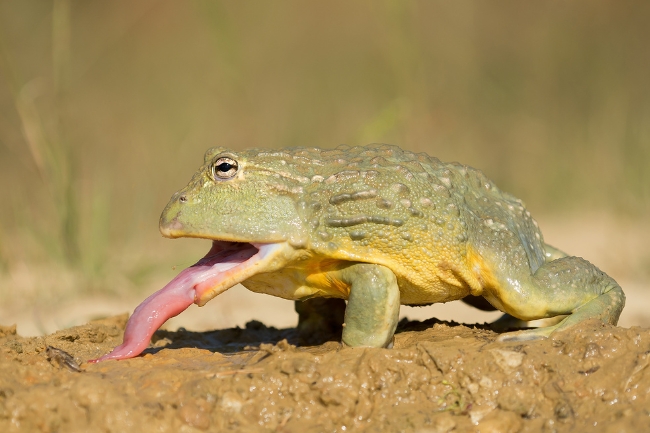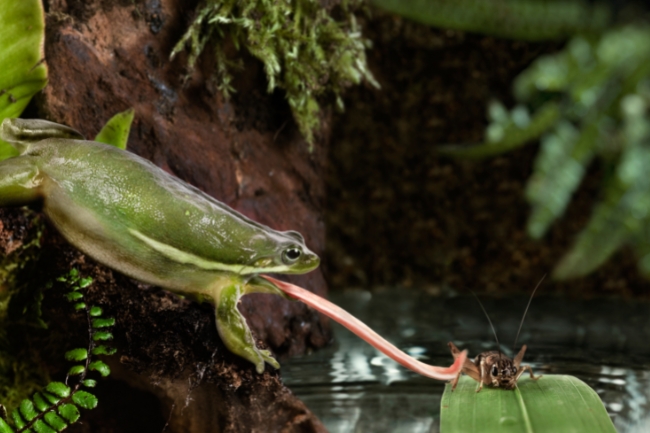How long a frog’s tongue is depends on the species, however their tongues are generally a third the length of their bodies.
The length of a frog’s tongue varies with species. This is in part because a the length of a frog’s tongue is generally relative to the length of the rest of its body. As a rule of thumb, a frog’s tongue is usually around a third of the rest of its body. This may not seem like much, but if humans had equivilently long tongues it could reach to our belly buttons.
How do they use their tongue?
Frogs tongues are generally this long to help them with their very specialised way of hunting prey. Most frog species use their tongue as a kind of lasso, shooting out and pulling prey back into their mouths.
| Frog Species | Average Tongue Length (in centimeters) | Maximum Tongue Length (in centimeters) | Notes |
|---|---|---|---|
| Red-eyed Tree Frog | 7.5 (2.95 inches) | 10 (3.93 inches) | Highly elastic tongue, used for capturing prey from a distance |
| African Bullfrog | 12 (4.72 inches) | 15 (5.90 inches) | Impressive tongue length for engulfing larger prey |
| Pacman Frog | 5 (1.95 inches) | 7 (2.75 inches) | Stout, muscular tongue adapted for ambush-style feeding |
| Green Tree Frog | 6 (2.36 inches) | 8 (3.15 inches) | Moderate tongue length suitable for a variety of prey |
In order to achieve their amazing feat, frog’s tongues have a number of unusual features.
Tongue positions
Firstly, a frog’s tongue is located at the front of their mouths. This is different from humans, whose tongues are attached at the back of their mouths. This allows the tongue to stretch out further.
Musculature
A frog’s tongue is made up of a fascinating group of muscles. These are usually relaxed, but when prey is spotted, one set stiffens, causing the tongue to shoot out. As the tongue connects with the prey, another set of muscles contracts, pulling the tongue back into the mouth.
Softness
One particularly bizarre aspect of a frog’s tongue is that it is incredibly soft, ten times softer than a human tongue. This allows it to envelope its prey when it hits them, helping grab on to the prey to pull them back.

Saliva
A frog’s saliva is a fascinating liquid. It would be natural to assume a frog’s saliva is incredibly sticky, helping to stick prey to their tongue. However, the saliva actually changes its stickiness throughout the process of prey capture.
When in the frog’s mouth, the saliva isn’t particularly sticky. As the tongue hits the prey, the saliva is runny, like water. This allows it to enter into the shape of the prey, seeping into crevices. It’s as the tongue retracts that the saliva becomes sticky, five times stickier than honey. This sticky saliva pulls the prey back into the frog’s mouth, where it once again loses its stickiness, allowing the prey to be swallowed.
The ability for the saliva to change form based on certain conditions makes it a non-newtonian fluid. Custard is another well known non-newtonian fluid. When put under pressure custard can become solid.
All of these amazing features allow a frog’s tongue to become to ultimate weapon. Not only is it able to reach out long distances, and pull prey to their death, it can also move with lightning speed. A frog’s tongue can move five times faster than a human can blink. This is important when trying to capture prey such as flies, which are famously fast and agile.

Most frogs are also ambush predators, trying to remain hidden and strike out at their prey when least expected. This increases their chances of catching something tasty.
With some frogs, such as cane toads, researchers have found that the tongue recoils with so much force, that it disappears down the frog’s throat, further than it thrusts out to capture the prey.
The Tongueless Frog
Not all frog’s have tongues. The reason for this is largely because they are species adapted to living underwater, such as the African clawed toad. In their underwater homes, using their tongue to hunt would be less efficient. Instead, they hunt down their prey and use their claws to grasp them and force them into their mouths.
With this hunting technique, a long tongue would be more of a nuisance, rather than a help, meaning in time they simply lost them.
Also read: Frogs & Their Teeth (Do They Bite & Does it Hurt?)
Little frog, little tongue
Some of the smallest frogs in the world are poison dart frogs. Yet even these tiny frogs have long sticky tongues they use to catch their prey. The difference with smaller species is the prey that they target. For poison dart frogs their main prey is often small flying insects such as gnats.
| Frog Life Stage | Tongue Length (in centimeters) | Developmental Notes |
|---|---|---|
| Tadpole | 1.2 (0.47 inches) | Tadpoles have small, rudimentary tongues for feeding on algae or detritus |
| Juvenile Frog | 3.5 (1.37 inches) | As frogs develop, their tongues grow longer and more muscular |
| Adult Frog | 6.8 (2.67 inches) | Adult frogs exhibit their maximum tongue length for effective prey capture |
By comparison larger frogs such as the pacman frog, have much larger tongues, but still in proportion to their body length. These larger frogs can target much larger prey with their tongues, such as mice, other frogs and reptiles.
Despite their difference in sizes, these very different frogs use the same hunting technique to get their prey, demonstrating how versatile this method of capturing prey really is. It’s perhaps lucky that there are no frogs big enough to catch us humans, or perhaps we too would come to a sticky end.

